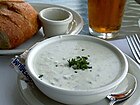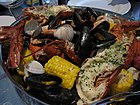 | |
| Type | Bread roll |
|---|---|
| Place of origin | United States |
| Associated cuisine | New England |
| Created by | Parker House Hotel |
| Main ingredients | Flour, milk, butter or margarine, eggs, sugar |
A Parker House roll is a bread roll made by flattening the center of a ball of dough with a rolling pin so that it becomes an oval shape, and then folding the oval in half. They are made with milk and are generally quite buttery, soft, and slightly sweet with a crispy shell.
They were invented at the Parker House Hotel in Boston, during the 1870s. The story of their creation has several variations, but they all involve an angry pastry cook throwing unfinished rolls into the oven, which results in their dented appearance. The recipe for Parker House rolls first started appearing in cookbooks in the 1880s. Fannie Farmer gives a recipe for them in her 1896 The Boston Cooking-School Cook Book.
See also
References
- Smith, Andrew F, ed. Oxford Encyclopedia of Food and Drink in America. New York:Oxford University Press, 2004, Volume 1
- Mariani, John F. Encyclopedia of American Food and Drink. New York:Lebhar-Friedman, 1999
- Early, Eleanor. New England Cookbook. New York:Random House, 1954
- Smith, Andrew F, ed. Oxford Encyclopedia of Food and Drink in America. New York:Oxford University Press, 2004, Volume 1
- Forbes, Esther, and Arthur Griffin. The Boston Book. Houghton Mifflin Company: 1947.
- Morrisey, Louise Lane, and Marion Lane Sweeney. An Odd Volume of Cookery. Houghton Mifflin Company: 1949.
External links
| American breads | |
|---|---|
| American breads | |
| Miscellaneous | |
| Cuisine of New England | ||
|---|---|---|
| Soups and stews |    | |
| Sandwiches | ||
| Seafood dishes | ||
| Baked dishes | ||
| Sauces and condiments | ||
| Desserts and sweets | ||
| Beverages | ||
| Miscellaneous | ||
| Breads | ||
| Related topics | ||
This bread-related article is a stub. You can help Misplaced Pages by expanding it. |